
The types of worms that infect a person's internal organs are called helminths (worms). According to statistics, today about 30% of the total population is susceptible to helminthic invasion. The worms that poison the body can infect any part of the body. This is dangerous not only for diseases that can cause helminths. Its presence in the body can be fatal.
So far, helminthiasis can be completely cured not only with medications, but also with folk remedies. Each type has its own treatment methods. Therefore, it is worth knowing and understanding what types of worms are, as well as the symptoms of a parasitic infection, to take timely action.
Helminthiasis classification
Parasitic worms are divided into two large groups: intestinal and tissue.
The first species lives directly in the intestine. This group includes:
- roundworms and pinworms;
- hookworms and lamblia;
- whipworms and dwarf tapeworm;
- bovine tapeworm and broad tapeworm;
- pig tapeworm.
Tissue worms can inhabit any organ in the human body and parasitize for many years. These include:
- cysticerci and trematodes;
- trichinella and liver worm;
- echinococcus and alveococcus.
Roundworm
They are the most common and complicated types of worms that live in the small intestine of an adult or a child. Infection with this type of helminth is called ascariasis.
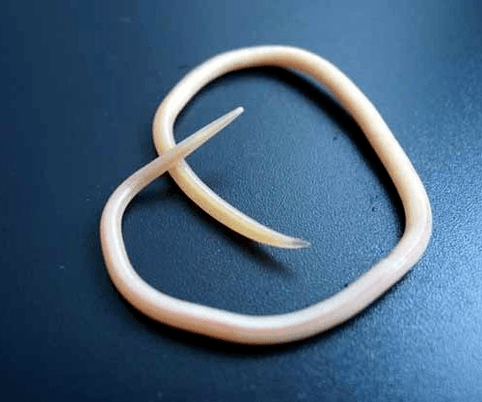
In the first days of the invasion, the individual begins to feel unwell, nervousness, fever, shortness of breath, cough and pain in the chest area. Such symptoms are justified by the fact that helminths initially affect the respiratory system.
Infection can occur from drinking raw water from unverified sources, poorly processed fresh fruits and vegetables. In summer, the risk of ascariasis increases.
Earthworms
Small helminths that settle in the intestines cause a disease called enterobiasis. The worms lay their eggs in the anal area. The eggs laid are transformed into larvae and can only re-enter the body through the oral cavity.

Re-infection occurs through the contact of the dirty hands of a person with enterobiasis with the food they eat. Symptoms of infection can include itching around the anus and increased irritability.
Important! The disease is transmitted by humans.
Hookworm
Hookworm infection occurs through damaged skin in contact with the soil, where the larvae of these types of worms live.
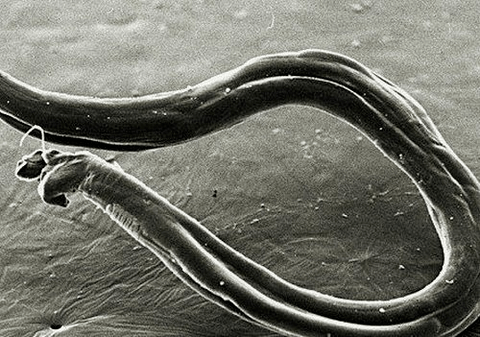
Hookworms, before entering the intestines, follow the same path as roundworms.
Symptoms include coughing, pain in the lower abdomen, nausea and disturbed stools. This type of helminthiasis can cause anemia.
Giardia
Giardiasis progresses in people who have a habit of biting their nails and other objects (pencils, pens). The infection can also occur in the case of ingestion of poor quality water, unwashed products, contact with dirty clothes, where larvae may be, and carrier of the disease.

Symptoms of infection can include loose stools and lower abdominal pain.
Vlasoglava
Trichocephalosis occurs during infection by tricurid larvae. They come in along with unprocessed fruits and vegetables. Dirty hands and water are also vectors.

The invasion is accompanied by acute abdominal pain, diarrhea and decreased appetite. Signs of infection are often similar to appendicitis.
Dwarf tapeworm
Infection with the worm occurs not only through dirty hands and unwashed foods, but insects can also be transmitters.
The dwarf tapeworm affects the intestines and the liver, causing inflammation and poisoning.
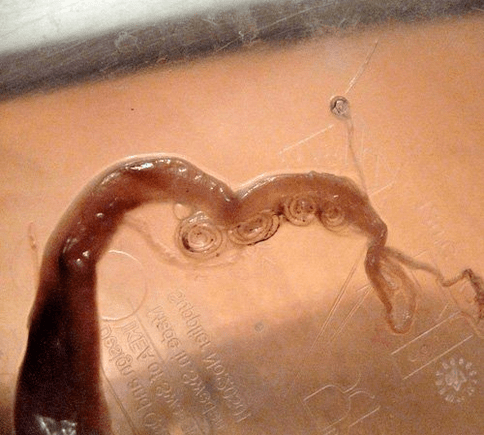
Hymenolepiasis can be accompanied by the appearance of dysbiosis, decreased appetite, increased thirst, increased fatigue and nervousness.
Bovine tapeworm
One of the most dangerous types of worms that parasitize the large intestine.
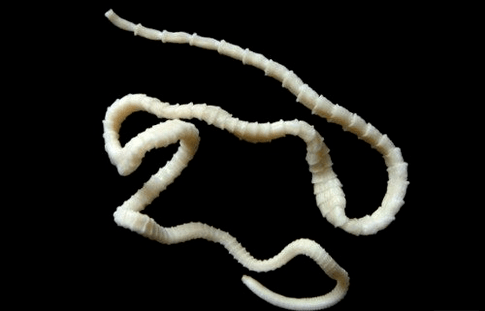
An adult worm reaches several meters in length. The individual takes away all the nutrients from the human body and produces serious intoxications.
The symptoms of the invasion are:
- diarrhea and abdominal pain;
- vomiting and nausea;
- restless sleep;
- dizziness and fainting.
The risk of teniarinhoses disease arises when ingested meat that is insufficiently processed and contaminated with bovine tapeworm larvae is eaten.
Wide ribbon
The cause of diphyllobotriasis is the consumption of poorly processed fish products and caviar.
The worm that causes the disease is one of the largest and can reach ten meters.
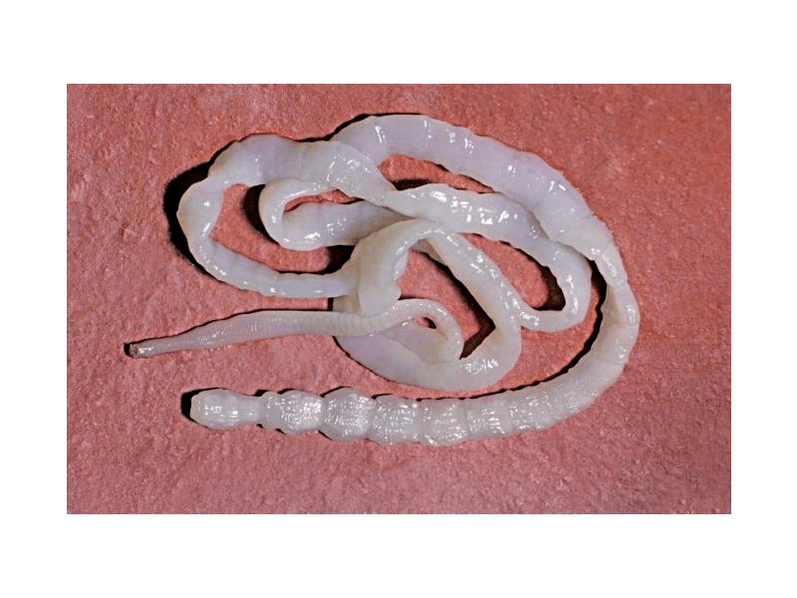
Symptoms of infection are severe pain in the lower abdomen and anemia.
Swine tapeworm
Infection with this type of helminth is extremely dangerous for humans. Eating pork that has not been cooked enough can cause Finns to enter the body and become adults.

From the body of the pig's tapeworm, the so-called segments are periodically separated, which can leave the body alone through the anus or with feces, entering the environment. The signs of teniasis are similar to those of a bovine tapeworm infection.
Cysticerki
It is a type of worm that is the product of a segment of pork tapeworm. Segments containing tapeworm eggs enter the external environment and can re-enter the body through external environmental objects and cause the development of cysticercosis.

The parasites take up residence in the muscles, the myocardium and even the brain.
Important! They have a compression effect on the organs and cause inflammation.
Liver event
Opistorchiasis occurs as a result of ingesting liver fluke larvae along with infected fish in the human body.

Signs of presence of opistorchiasis:
- nausea;
- diarrhea;
- pain throughout the body;
- the occurrence of allergies.
The most serious symptoms are chronic. This type of parasite is dangerous for the development of liver cancer.
Echinococcus
The worm settles in the body, most often in the liver or lungs. The echinococcus can cause the formation of a cyst in the affected organ and the appearance of tumors. The infection can be fatal.

Larvae are transmitted to humans through contact with sick animals.
Trichinella
Trichinosis mainly affects people who eat poorly processed meat from wild animals. Pigs can also carry Trichinella.

The habitats of adults in the human body are various types of muscles (respiratory, facial, etc. ).
In an early stage, nausea and loose stools occur. Subsequent symptoms of the invasion are fever, edema, skin rashes and muscle pain. Infection with this type of parasite without timely treatment can be fatal.

Forms of human helminth infection
- Biohelminthiasis (infection of animals).
- Contagious helminthiasis (transmitted from person to person).
- Geohelminthiasis (diseases caused by parasites that carry out one of their life cycles on Earth).
Factors affecting the manifestations of helminthiasis

The way the parasite enters the body;
- The degree of adaptation of the helminth to the human body;
- Population density (number) of parasitic individuals;
- The worm habitat (the tissue parasites live in the thickness of the soft tissues and the luminous ones live in the gaps in the hollow organs). Some helminths in different phases have luminous and tissue forms. The larval and developing stages of worms, as a rule, cause more pronounced pathological changes.
In the absence of reinfection, the number of adult parasites in the human body does not increase. This characteristic significantly distinguishes helminthic invasions from diseases caused by bacteria, viruses, fungi and protozoa.
Worms in humans: symptoms
Helminthiasis is a disease characterized by 2 stages of evolution (acute, from two weeks to two months) and chronic (from several months to several years).
Symptoms of the acute phase of helminthiasis
The first signs of the disease may appear at different times (most often after 2-3 weeks, with ascariasis - after 2-3 days, and with filariasis, the incubation period can last 6-18 months).
In the acute stage of parasitic invasion, the most characteristic symptom is an allergic reaction (antibodies are produced to the antigens of the parasite's migrating larvae). Often, in people infected with worms, itchy rashes appear on the skin, with a tendency to a recurrent course, enlargement of regional lymph nodes, generalized or local edema, muscle and joint pain may occur. In addition, migration of the parasite's larvae can cause chest pain, coughing, choking attacks, disturbed stools, nausea and vomiting.
Signs of chronic helminthiasis
The symptoms of the chronic phase depend directly on which organ is "inhabited" by the parasites, and also their size and number play an important role.

Therefore, when parasitizing the intestines of isolated individuals, the disease can be asymptomatic (except in cases of infection by very large parasites). The characteristic signs of the chronic phase of intestinal helminthiasis are dyspeptic disorders. In children, the astenoneurotic and painful syndrome is more pronounced. With the massive invasion of roundworms, the development of intestinal obstruction, obstructive jaundice and pancreatitis is possible.
In people suffering from helminthiasis, due to a weakened immune system and an intensified process of cell division (a consequence of the constant restoration of tissues damaged by parasites), the risk of malignant tumors increases significantly.
Types of helminths parasitizing in the human body
The causative agents of human helminthiasis are 2 types of worms: round (nematodes) and flattened (ribbon and worms).
Round worms
Pinworm

The parasites that cause enterobiasis are small cavity worms (up to 10 mm) with a gray-white color. The infection occurs through food (through the mouth). The reason for this is dirty hands. The parasite's eggs can be found in the soil, in the wool of infected animals, unwashed vegetables and fruits, etc. At the same time, with enterobiasis, cases of autoinfection (mainly in children), resulting from scratching of the itchy areas and subsequent swallowing of eggs, are frequent. The moth larva develops in two weeks in the digestive tract. Having become an adult, the parasitic worm in the lower sections of the small and upper sections of the colon.
Ascaris

Ascaris is a large fusiform parasite of red-yellow color, reaching 40 cm (females) and 15-25 cm (males) in adulthood. Without suction cups or other fixing devices, the roundworm is able to move independently towards the masses of food. The eggs laid by the female of the parasite are excreted along with the feces.
Vlasoglav
Vlasoglav, the causative agent of trichocephalosis, is a white helminth that parasites in the initial section of the large intestine and reaches a size of 4-5 cm. The parasite feeds on blood and tissues of the rectal mucosa.
With a small number of worms, trichocephalosis is asymptomatic. In a severe phase (with massive invasion), the patient develops abdominal pain, develops severe diarrhea, sometimes accompanied by rectal prolapse. This condition is most often seen in debilitated children. With a moderate stage of trichocephalosis, the child's growth retardation is possible.
Trichinella

The causative agent of trichinosis is a small round helminth, with a length of 2 to 5 mm. The infection occurs when eating undercooked meat (pork, bear meat, wild boar). Penetrating the intestines, the parasite's larva matures in 3-4 days to the state of a sexually mature individual. The worm's lifespan is 40 days, after which the parasite dies. When perforating the intestinal wall, the larvae enter the bloodstream and are transported to all organs of the human body, settling in the muscles. In this case, the respiratory and facial muscles, as well as the flexor muscles of the limbs, are the most affected.
In the first days after the invasion, patients complain of abdominal pain. Then, after about 2 weeks, the body temperature rises to 39-40 C, itchy rashes appear on the skin, develop muscle pain and the face swells. During this period, in case of massive infection, there is a significant risk of death. After about a month, the patient recovers. The parasite is encapsulated in a spiral form, after which it dies in two years.
Hookworm and Nekator
These two parasites are similar in biological characteristics, as well as in diseases caused. In this regard, it is customary to combine them under a common name (hookworms). Worms, reaching lengths of 10-15 mm, parasitize in 12-p. intestine. It should be noted that this is one of the most common parasites, but, at the same time, rarely detected. Worm larvae enter the human body through the skin in contact with contaminated soil. In addition, when they enter the bloodstream, they, like roundworms, migrate to the lungs and then through the bronchi, along with sputum, to the digestive tract. Ankylostoma parasites in the intestine, adhering to the intestinal wall. Therefore, the most characteristic symptom of this helminthiasis is iron deficiency anemia, as well as a change in the proportion of protein fractions (dysproteinemia).
Flat earthworms
Wide ribbon
It is one of the largest helminths, reaching a length of 10 to 20 meters. The disease caused by this parasite is called diphyllobotriasis. The worm's development cycle begins with freshwater fish or crustaceans. The larva enters the human body, which is the final owner of the tapeworm, along with infected fish eggs or fillets. Reaching the small intestine, the parasite attaches itself to its wall and becomes a mature individual in 20-25 days.
Diphyllobotriasis occurs in the context of disorders of the digestive tract and anemia due to B12 deficiency.
Liver event
The parasite that causes opistorchiasis is a flattened worm that reaches 7-20 mm in length. Human infection occurs when eating contaminated fish meat that has not undergone sufficient heat treatment. The larva of the hepatic worm in the small intestine enters the bile ducts and the gallbladder, fixing itself there with the help of two suction cups.
In the acute phase of helminthiasis, the patient experiences pain in the upper abdomen, increased body temperature, nausea, development of muscle pain, diarrhea and the possibility of skin rashes. The chronic course of opistorchiasis is manifested by symptoms of hepatitis, inflammation of the bile ducts, cholecystitis, disorders of the digestive tract, nervous disorders, weakness and increased fatigue. The parasite leads to the development of irreversible changes and, even after its expulsion, the patient does not present chronic inflammatory processes and functional disorders.
Bovine and swine tapeworm
These parasites, almost identical in structure, reach a length of 5 to 6 meters. Infection with teniarosis and teniasis occurs due to the consumption of infected beef or pork by the Finns (one of the intermediate forms of helminthiasis). Viable Finns, presented in the form of whitish bubbles that reach 0. 5 cm in size, attach themselves to the wall of the human small intestine and become adults in 3 months. The tape parasite, which consists of more than 2, 000 segments, is constantly growing.
Echinococcus

For this parasite, a person is an intermediate host. The worm parasites the human body in the form of the Finns. The final owner of the echinococcus is a wolf, a dog or a cat. The infection occurs by feeding through contact with animals and with environmental objects sown with Echinococcus eggs. After entering the intestine, oncospheres (larvae with six hooks) develop from them. From the intestines, they enter the bloodstream and are transported throughout the body.
Alveococcus
This parasite, considered a type of echinococcus, is the cause of one of the most dangerous helminthiasis (alveococcosis), which is similar in severity to cirrhosis and liver cancer. Infection occurs when oncospheres (eggs with mature larvae) penetrate the intestines. Laurocysts are very aggressive formations that grow constantly due to blisters that increase in size and also have the ability to grow to the liver, such as cancer metastases. Necrotic changes due to disturbances in the functioning of blood vessels undergo necrotic changes in the surrounding tissues. Spreading to nearby structures, the alveococcus forms fibrous nodules with inclusions of multi-American bubbles. This condition can last for several years and therefore requires mandatory surgical intervention.
Diagnosis of helminthiasis
The diagnosis of helminthic invasions includes the following activities:
- careful collection of anamnesis, which helps to discover possible causes of infection;
- laboratory tests for feces, blood, intestinal contents 12p, rectal and perianal mucus, muscle tissue, pulmonary expectoration, bile. Analysis can reveal parasite eggs, segments or fragments. At the same time, an increased content of eosinophils in the blood is also a sign of the presence of helminthiasis.
- in the diagnosis of diseases caused by larval phases or tissue parasites, serological tests are performed (ELISA, RSK, indirect agglutination reaction, immunofluorescence analysis, etc. ).
- to identify worms that affect liver tissue, ultrasound, computed tomography and endoscopic studies are prescribed.
Worms in humans: treatment
In the acute phase of parasitic infection, the patient is prescribed for detoxification and desensitization therapy. In severe cases of the disease (liver flukes, trichinosis), glucocorticoids are used according to medical instructions.
As specific therapy drugs, taking into account the nature of the pathogen, special anthelmintic chemotherapy drugs are prescribed.
In parallel, the patient is recommended to use antihistamines and enterosorbents. The final stage of treatment includes the use of probiotics that normalize the intestinal microflora.
A special mild diet is also prescribed (foods must be digestible and low in fat).
During the anthelmintic therapy period, the patient must strictly observe personal hygiene (to avoid reinfection). At the same time, for many helminthiasis, all family members and people who are in constant contact with those infected must be treated.
An underestimation of their danger, combined with a lack of knowledge of the biology of these creatures and the forms of infection with them, has led to the fact that at least several billion people are now carriers of certain parasites.
Parasites can also be present not only inside a person, but also outside the human body.
Prevention of parasite infestation
Rule 1:you cannot eat anything that is not sufficiently salted, fried or cooked. Sushi, lightly salted herring or sashimi can be considered gourmet food. But, in essence, it is raw fish, and fish is one of the components of the life cycle of parasitic worms.
How it all happens:first, the larva enters the mollusk, where it does not grow more than a certain limit, then the fish eats the mollusk, the larva enters its digestive tract, remaining alive, then it grows and multiplies, entering the muscle tissue of the fish, thenthis fish is eaten by a dolphin, seagull or polar bear. Or a restaurant visitor who decides to join Japanese high culture.
Safe raw fish exists in theory. To do this, it must be immediately frozen after being caught and thawed immediately before cooking, or it must be grown especially on a fish farm with control of the absence of parasites. But it is usually impossible to verify that a risky dish was actually prepared from it.
The same care must be taken with the meat: do not try raw minced meat and freshly salted bacon.
In addition, to avoid being infected with helminths, vegetables must be washed before eating, as well as hands. As a component of the natural environment, these parasites in the human body are found almost everywhere.
Any contact of food or hands with the soil, dirt, dust and vegetation can leave your microscopic eggs in the food. If they enter the intestine, the worms will hatch from the eggs, which will not be easy to remove.
There are parasites that attack a person who is walking or relaxing in nature, for example:
- plasmodium of malaria, contained in the saliva of mosquitoes of the genus Anopheles,
- the causative agent of encephalitis contained in the saliva of ixodid ticks,
- fly and wolfarth fly.
Its prevention consists of the use of all types of repellents in nature walks, as well as the maximum protection of the open areas of the body (mosquito nets, nets, special gel).
However, what can you do if prevention has not helped? As the attack has been known for a long time, treatment with popular methods has also been known for a long time.
In conclusion, it can be noted that the observance of simple rules of hygiene and sanitation, the extermination of flies and cockroaches, can significantly reduce the risk of infection by parasites, leading to serious consequences.
























